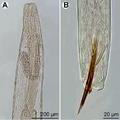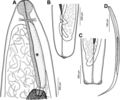
The bigeye scad or big-eyed scad is a species of oceanic fish found in tropical regions around the globe. Other common names include purse-eyed scad, goggle-eyed scad, akule, chicharro, charrito ojón, jacks, matang baka, mushimas and coulirou. The bigeye scad is fished commercially, both for human consumption and for bait.

The map puffer, also known as the map pufferfish, scribbled pufferfish, or Kesho-fugu, is a demersal marine fish belonging to the family Tetraodontidae. The map puffer is typically found in tropical and subtropical waters from the Indian Ocean to the western Pacific Ocean. This fish contains tetrodotoxin, a potent and deadly chemical compound used to ward off predators. Despite being highly poisonous, the map puffer can be found both in the aquarium trade and certain food markets.

The blacktip grouper, also known as the redbanded grouper, blacktipped cod, black-tipped rockcod, footballer cod, red-barred cod, red-barred rockcod, scarlet rock-cod or weathered rock-cod, is a species of marine ray-finned fish, a grouper from the subfamily Epinephelinae which is part of the family Serranidae, which also includes the anthias and sea basses. It is found in the tropical Indo-Pacific region. It is the type species of the genus Epinephelus.

The mottled grouper is a species of marine ray-finned fish, a grouper from the subfamily Epinephelinae which is part of the family Serranidae, which also includes the anthias and sea basses. It is found in the eastern Atlantic Ocean and the Mediterranean Sea.
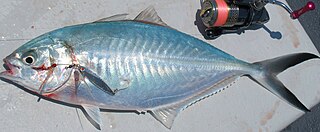
The herring scad, is a common species of tropical marine fish in the jack family Carangidae. The species inhabits the surface waters of coastal regions throughout the Indo-West Pacific region, feeding on a variety of crustaceans and small fishes. It is the largest fish of the scad genus Alepes, growing to a recorded length of 56 cm. The herring scad is identified among the genus Alepes by its more numerous and smaller scutes and the number of gill rakers on the first arch. It is of minor importance to fisheries throughout its range.
Philometra priacanthi is a species of parasitic nematode of fishes. Its name is derived from its host species, Priacanthus hamrur. It possesses dorsal lamella-like structures on the distal part of its gubernaculum, which can also be found on other of its cogenerates. The only species with a dorsal protuberance near the gubernaculum's end is P. priacanthi, however. P. lateolabracis can be distinguished from the former by the lateral caudal mounds separated dorsally, narrower lamella-like structures on its gubernaculum, shorter spicules, and by the testis extending anteriorly. Other gonad-infecting species differ from this one by possessing a smooth gubernaculum, and their spicules being of different lengths. Seven gonad-infecting species of Philometra can be distinguished from P. priacanthi by their host types, as well as by geographical distribution.
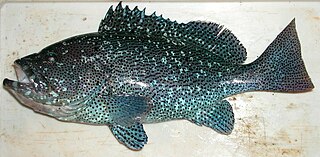
Philometra cyanopodi is a species of parasitic nematode of fishes, first found off New Caledonia in the South Pacific, in the gonads of Epinephelus cyanopodus. This species is characterized mainly by: length of spicules and length and structure of its gubernaculum; structure of male caudal end; body size; location in host and types of hosts.
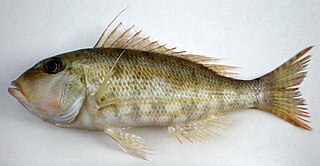
Philometra lethrini is a species of parasitic nematode of fishes, first found off New Caledonia in the South Pacific, in the gonads of Lethrinus genivittatus. This species is characterized mainly by: length of spicules and length and structure of its gubernaculum, structure of male caudal end, body size, location in host and types of hosts.
Philometra lagocephali is a species of parasitic nematode of fishes, first found off New Caledonia in the South Pacific Ocean in the abdominal cavity of Lagocephalus sceleratus. This species is characterized mainly by the length of its spicules, length and structure of its gubernaculum, body size, location in host and types of hosts.

Philometra fasciati is a species of parasitic nematode of fishes, first found off New Caledonia in the South Pacific, in the gonads Epinephelus fasciatus. This species is characterized mainly by: length of spicules and length and structure of its gubernaculum; structure of male caudal end; body size; location in host and types of hosts.
Philometra sphyraenae is a species of parasitic nematode of fishes, infecting the gonads of marine perciform fishes off the eastern Indian coast. It was first found in the pickhandle barracuda, Sphyraena jello. It is distinguished from its cogenerates by the gubernaculum structure in males, as well as the shape and structure of the females' cephalic and caudal ends, and their oesophagus.
Philometroides eleutheronemae is a species of parasitic nematode of fishes, infecting the gonads of marine perciform fishes off the eastern Indian coast. It was first found in the fourfinger threadfin, Eleutheronema tetradactylum. It is distinguished from its cogenerates by the gubernaculum structure in males, as well as the shape and structure of the females' cephalic and caudal ends, and their oesophagus.
Philometra otolithi is a species of parasitic nematode of fishes, infecting the gonads of marine perciform fishes off the eastern Indian coast. It was first found in the tigertooth croaker, Otolithes ruber. It is distinguished from its cogenerates by the gubernaculum structure in males, as well as the shape and structure of the females' cephalic and caudal ends, and their oesophagus.
Philometra gerrei is a species of parasitic nematode of fishes, infecting the gonads of marine perciform fishes off the eastern Indian coast. It was first found in the whipfin silver-biddy, Gerres filamentosus. It is distinguished from its cogenerates by the gubernaculum structure in males, as well as the shape and structure of the females' cephalic and caudal ends, and their oesophagus.

František Moravec is a Czech parasitologist who specialises on the Nematodes, especially the nematodes parasites of fishes. His research is mainly in the field of taxonomy of the Nematoda.

Ascarophis is a genus of parasitic nematodes, belonging to the family Cystidicolidae. Species of Ascarophis are parasitic as adults in the gastrointestinal tract of marine and estuarine fishes.

Ascarophisnema is a genus of parasitic nematodes, belonging to the family Cystidicolidae. Species of Ascarophisnema are parasitic as adults in the gastrointestinal tract of fish. According to the World Register of Marine Species, the genus currently (2019) includes a single species, Ascarophisnema tridentatum.

Moravecnema is a genus of parasitic nematodes, belonging to the family Cystidicolidae. Species of Moravecnema are parasitic as adults in the gastrointestinal tract of fish. According to the World Register of Marine Species, the genus currently (2019) includes a single species, Moravecnema segonzaci, which is a parasite in a deep-sea fish.

Ichthyofilaroides is a genus of parasitic nematodes, belonging to the family Guyanemidae Petter, 1974.
Philometridae is a family of nematodes belonging to the order Rhabditida. All Philometridae are obligate tissue parasites of fish.






